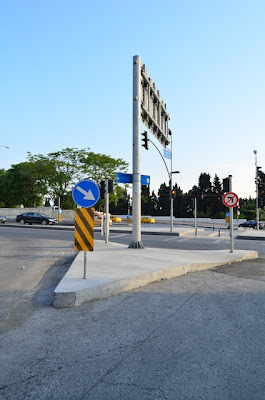Treading Along the Past
When we first enter the cemetery near the Şehitlik, H. tells us that none of this used to be like this. “That road cut there?” he motions, “wasn’t there, it was just fields.” We wander by the grave of Mehmet Akif, follow the boulevard along empty aisles shaded with dusty cypress. H. grew up outside the walls, watched the city unfold itself in the 1960s and 70s, then begin to fill back in upon itself in the 80s and 90s. He leads us out across the six lanes of traffic that feed into the city at Edirnekapı and we cut back into the cemetery along the other side. It’s an older plot, and we begin to find Ottoman-era graves scattered between more recent additions. H. is leading us towards the grave of İbn-i Kemal Hazretleri, the 9th Şeyhülislam of the Ottoman Empire.
We find the grave at the edge of a hill that slopes down to the expressway below. Pointing down at the ground, H. tells us that the road used to pass immediately in front of the grave but that when they built the expressway they rerouted everything. He walks us out onto the embankment and shows us a second gate to the grave. “That,” he says, “is where we used to enter.”
Later, we emerge onto a small road. H. continues to explain the paths of his youth, “This is the road that the minibuses would take, when they were going to Eyüp they would take the upper road, out through Rami and then down the hill, but on the return, they would come through Defterdar and Otakçılar, and then up to Edirnekapı again.” He turns us around and points to the two different layers of wall and curb, adds, “And this is where the two roads would come together.”
It’s almost possible to imagine the city as something imperfectly stitched together. If you look carefully enough -- or better, if you’re able to tread the city with someone from the city, with someone who can teach you how to look -- the places where different pasts, different projects, different imaginations of the city are joined together begin to emerge.
We eventually walk back to the main road running out of Edirnekapı out towards the new suburbs of the city. H. points across the road, says, “See, this is where the road used to go, it used to just go straight here and lead to Edirnekapı.” And suddenly an intersection that had previously seemed sort of senseless, almost accidentally, resolves into a site with its own particular history, its own stories of things that move and those -- like the graves -- that stay in place.
We find the grave at the edge of a hill that slopes down to the expressway below. Pointing down at the ground, H. tells us that the road used to pass immediately in front of the grave but that when they built the expressway they rerouted everything. He walks us out onto the embankment and shows us a second gate to the grave. “That,” he says, “is where we used to enter.”
Later, we emerge onto a small road. H. continues to explain the paths of his youth, “This is the road that the minibuses would take, when they were going to Eyüp they would take the upper road, out through Rami and then down the hill, but on the return, they would come through Defterdar and Otakçılar, and then up to Edirnekapı again.” He turns us around and points to the two different layers of wall and curb, adds, “And this is where the two roads would come together.”
 |
| Near Edirnekapı 6 May 2012 |
It’s almost possible to imagine the city as something imperfectly stitched together. If you look carefully enough -- or better, if you’re able to tread the city with someone from the city, with someone who can teach you how to look -- the places where different pasts, different projects, different imaginations of the city are joined together begin to emerge.
We eventually walk back to the main road running out of Edirnekapı out towards the new suburbs of the city. H. points across the road, says, “See, this is where the road used to go, it used to just go straight here and lead to Edirnekapı.” And suddenly an intersection that had previously seemed sort of senseless, almost accidentally, resolves into a site with its own particular history, its own stories of things that move and those -- like the graves -- that stay in place.
 |
| Near Edirnekapı 6 May 2012 |
Comments